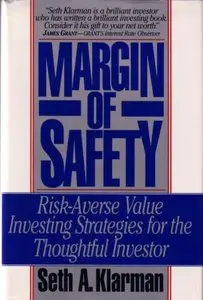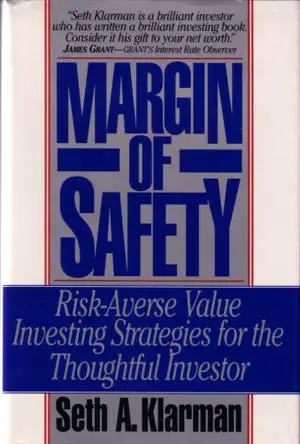Seth A. Klarman - "Margin of Safety: Risk-Averse Value Investing Strategies for the Thoughtful Investor", 1st Ed.
Publisher: Harper Collins | Pages: 249 | October 1991 | ISBN: 0887305105 | PDF | 0.9 Mb
Publisher: Harper Collins | Pages: 249 | October 1991 | ISBN: 0887305105 | PDF | 0.9 Mb
This book is one of the hardest finance books to track down today. Published in 1991, it is now out of print, and sells on Amazon and Ebay for over $1000. It is even one of the most-stolen library books, making it very difficult to find a copy to read.
Seth Klarman, the portfolio manager of The Baupost Group, is a very successful practitioner of the value investing strategy. In this book, he sets out to educate the reader on this concept, stressing the advantages of a risk-averse approach. In his introduction, Klarman states that even if this book, as a side effect of educating more people to invest in a more sophisticated manner, causes diminished returns to himself - he considers it well worth it for the public good. While I highly applaud this mentality, it begs the question: why was the book not published again? Considering what I mentioned in the first paragraph, clearly there is significant demand to read it. Anyway, on to the book itself…
"Margin of Safety" is divided into three portions. The first part discusses where most investors make mistakes and stumble - it covers investing vs. speculation, the nature of Wall Street, and how institutional investing results in a short-term performance derby (of which the client is ultimately the loser). It also encapsulates the presented information in a thoughful case study of junk bonds in the 1980s. The second portion of the book introduces the details of the value-investment philosophy, primarily focusing on risk and how it is crucial to invest with a margin of safety. The last part provides useful applicable advice on actually following the value-investment process: where to find investment opportunities, how to invest in these opportunities, and various aspects of overall portfolio management.
Simply put, the book is fantastic. Klarman writes in an amazingly clear manner. His language is neither too simplistic nor overly difficult - just right. I definitely experienced a "wow" feeling when I began reading, after the finance books I have read recently. In addition, Klarman provides a myriad of examples to illustrate the points he brings up, which is very helpful, because it puts a reality spin on his writings.
Don't, however, mistake "clear writing" for "easy content." While the book is clear, precise, and very straight-to-the-point (i.e. there is no useless fluff frequently found in books advocating certain investment approaches), Klarman's content is not trivial. The first and even the second portions of the book are relatively quick and simple - after all, the material presented (a discussion of various common investor mistakes, followed by the basic explanation of value investing) is not overly difficult. The third and last portion of the book, however, is very dense: a lot of information is presented quickly. I actually found myself having to re-read a few of the later chapters multiple times, making sure I understand what Klarman was trying to illustrate. I took notes while reading, so that helped absorb the material - but it still wasn't easy.
This brings me to the only personal gripe I had with the book. There were multiple instances in the later chapters where I wished that Klarman would elaborate more on some of his statements and examples (for instance, calculating NPV for certain businesses, more discussion on thrift institutions, etc.). The author certainly assumes some previous experience, as some of his non-basic explanations are clearly not geared for outright beginners. There was never a point, however, where I felt completely out of the loop. I had to read some portions over again and even look up additional information on the web, but in the end Klarman's words always made sense.
This book is absolutely the best overview of value investing I have ever read or heard. Klarman stresses the importance of carefully evaluating risk (as we often only focus on return) and investing with a margin of safety. He repeats this main point over and over again throughout the entire book. Amazingly, it doesn't feel overly repetitive - but instead, a constant timely reminder of the ideas behind the value investing process. A major theme in the book is that we can't predict the future, and hence we must always be ready for anything - and the only way to do this is to protect our investments with a sufficient margin of safety (essentially investing in a security at a significant discount to underlying value).
Aside from a clear explanation of his investing philosophy, Klarman provides tons and tons of useful practical advice, from how to valuate businesses (he makes sure to distinguish his preferred methods from other widespread strategies) to where to find excellent investment opportunities for value investors. He devotes multiple chapters to discussing the frequently neglected portions of the market where low-risk and potentially high-return investments can be made. In the last two chapters, Klarman takes a step back from discussing individual investments and focuses on overall portfolio management and various alternatives for the individual investor.
One may wonder how applicable some of the specific advice is today. Are thrift conversions really still good places to find hidden value? Maybe not. Is manually calculating the cash flow of a business through the faulty measure of EBITDA still a problem today? Not really, since cash flow statements are now part of the required financial statements for public companies. But a lot of Klarman's essential advice (do your analysis carefully - look behind the numbers) and much of his presented "fertile ground for opportunities" still applies and exists today. Furthermore, the wonderful thing about value investing is that it is contrarian in its nature - which essentially implies that, as investments in various portions of the market come in cycles, a value investor can patiently wait for a popular area to "overflow", collapse, and offer excellent opportunities to invest while the herds of investors shy away and sell out. So even if some of Klarman's hunting grounds may seem outdated right now, they will again be attractive in the future.
One thing to note is that each chapter contains a set of footnotes. I advise the reader not to ignore these - they sometimes contain interesting examples and valuable advice. Unfortunately, they are easy to skip, as they're not printed at the bottom of the page which references the footnote, but rather at the back of each chapter.
In conclusion, I highly recommend Klarman's book to… anyone, really! Seasoned veterans will undoubtedly find excellent insight into things that may have before seemed ordinary and trivial. Beginners will learn fantastic advice that may help steer them away from poor decisions made by many inexperienced investors today. I personally don't think it is worth paying the market price for the book today just to read it (although many may argue that even the going price is at a huge discount from the underlying value) - but I suggest trying to obtain the book through an Inter-Library Loan. It may take some time and effort to find a copy, but it's well worth it.
Pros:
- clear and concise writing, no fluff
- lots and lots of illustrative examples
- very clear explanation of the basic concept of value investing and a margin of safety
- useful methods for researching and valuating a business
- tremendous amount of applicable advice on finding and analyzing investment opportunities
- lots of other real-world advice on various topics from portfolio management to money manager selection
Cons:
- last portion of the book is dense, may require careful reading and re-reading
- a small portion of the material may be slightly out of date (don't let this deter you)
(Thanks to the original uploader and to the original reviewer).



